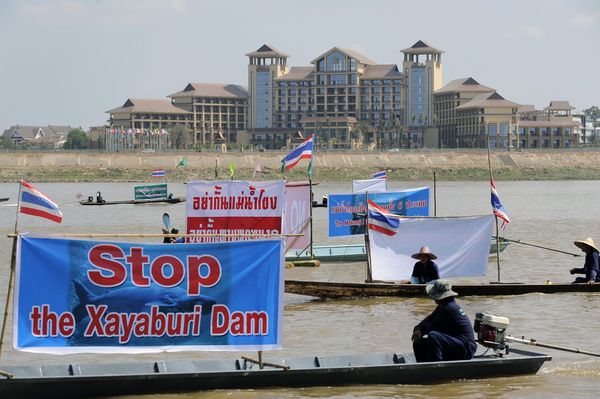
Laos to begin building hotly debated Xayaburi
dam this week
Nov 6, 2012 -
Los Angeles Times

Laos plans to start building a dam on the Mekong
River this week, a step that neighboring Cambodia
and Vietnam fear could imperil fish and cripple rice
fields.
The Xayaburi dam is expected to reap profits for
Laos by generating hydropower to sell to Thailand.
The $3-billion-plus project would be the first major
dam on the lower part of the Mekong, a massive waterway
that provides food and jobs to millions of people
in Southeast Asia.
Building the dam marks the latest push toward development
for Laos, a growing economy seeking to shed its “least
developed country” label. The communist country
has opened up its economy over the last few decades
and was recently accepted into the World Trade Organization.
“Hydropower is a big natural advantage for
Laos,” Deputy Minister of Energy and Mining
Viraphonh Viravong told Bloomberg on Monday.
But Vietnam and Cambodia worry dams could endanger
fish that families eat and hurt crops in the Mekong
Delta, the “rice bowl” of the region.
Environmental experts warn if fish dwindle and croplands
are lost, damming the river could cost more than
it brings in. A Portland State University study last
year estimated losses could run as high as $274 billion
if a passel of planned dams are built.
A regional report recommended waiting for more studies
to assess the dangers, but Laos has pressed ahead.
“They are playing roulette with the Mekong
River,” said Ame Trandem, Southeast Asia program
director for International Rivers. “There are
serious risks for the river and the people who depend
on it.”
Laos says it addressed those concerns in the design
of its dam, using special features that allow migrating
fish to pass through. But Trandem and other environmentalists
say those strategies are unlikely to work in the
Mekong, populated by some of the biggest fish in
the world.
Under an agreement struck 17 years ago, Laos is supposed
to consult with Vietnam, Cambodia and Thailand on
damming the whole river, under the shared Mekong
River Commission. The Laotian government has reportedly
argued the agreement doesn’t apply in this
case. The decision to build the Xayaburi dam appears
to flout the pact.
There was no immediate reaction from Cambodia or
Vietnam when Laos announced its plans Monday. Thailand,
which is hungry for new sources of power, has agreed
to buy the electricity, though a group of Thai villagers
are suing their government over the plans and protested
on the river Monday.
The news went out the same day that a meeting of
European and Asian leaders opened in Laos, a surprise
to Southeast Asia watchers who had expected the issue
to be hashed out during the summit this week. The
way the region reacts could spell out the future
of the Mekong.
“This is the opening of Pandora’s box,” said
Nathanial Matthews, a hydropower researcher at King’s
College London. “Unless there is real pushback
in the next six months, I see Laos moving ahead quite
quickly with the rest of the dams.”
Eleven dams are planned for the lower Mekong. The
next test will be whether Laos follows the same path
in pursuing the next project, or whether it bends
to neighbors’ concerns. One expert said Xayaburi
might have been a unique case because lots of money
had already been sunk into preparing the site.
“They could still do it right for the next
one,” consulting neighbors and paying attention
to their worries, said Richard P. Cronin, director
of the Southeast Asia Program at the Stimson Center. “But
if they build all of these dams, that will be the
coup de grace for the Mekong Delta.”
ALSO:
Car bombs, aerial attacks pummel Syria
Prosecutors in Afghanistan massacre case face tough
challenge
Report: Israel leaders ordered preparedness for
Iran strike in 2010
-- Emily Alpert in Los Angeles
Photo: Laotian territory provides a backdrop as
Thai activists and villagers affected by the controversial
Xayaburi dam express their opposition on the Mekong
River in Nong Khai province on Monday. Credit: European
Pressphoto Agency / The Network of Thai People

|



